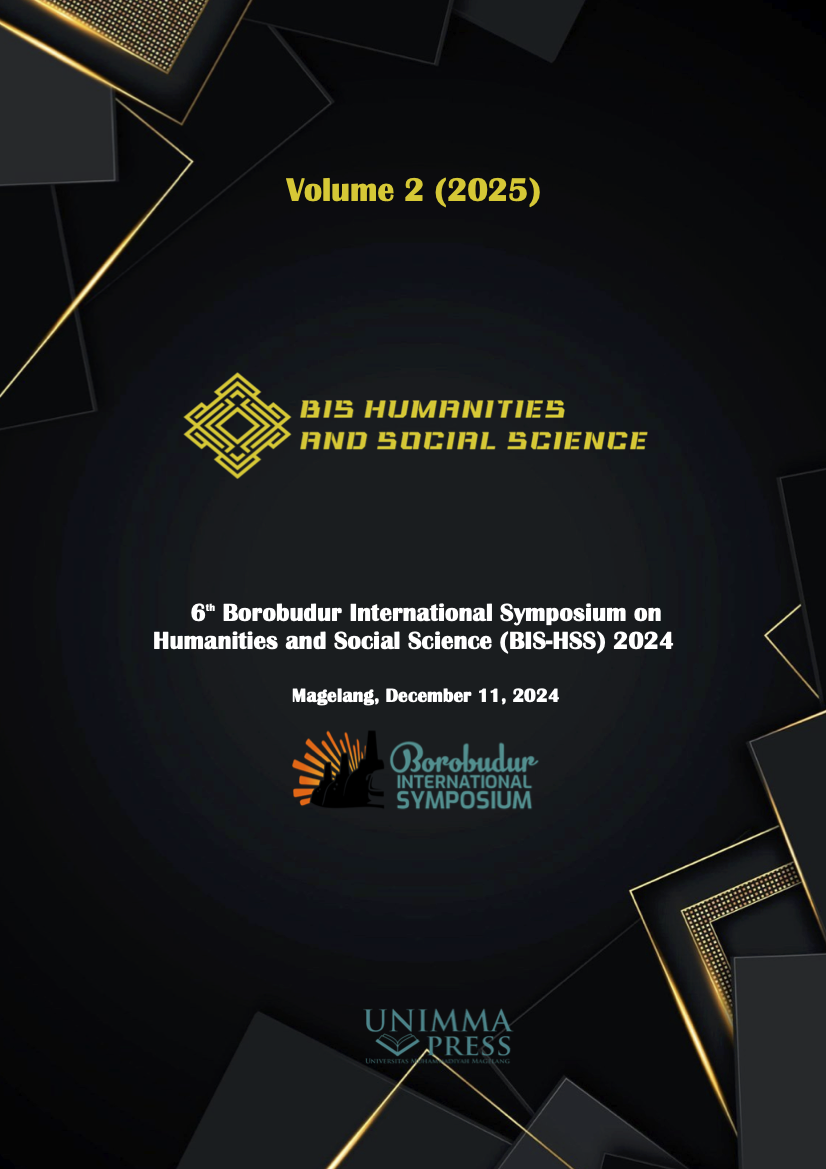Empathic communication of employers with domestic helpers in realizing work comfort
Keywords:
Empathic communication, Employer, Domestic helper, Work comfort, Working relationshipAbstract
The working relationship between employer and domestic helper is often characterized by communication problems that affect work comfort. Lack of empathic communication, such as lack of attention, emotional distance, and limited dialogue space, are the main factors that cause discomfort. This research explains the empathic communication process between employers and helpers in realizing work comfort. The method used in this research is descriptive qualitative. The data collection technique used was in-depth interviews with three pairs of employer and helper informants, which were conducted using a purposive sampling technique based on research needs. The results showed different conditions in each pair when carrying out empathic communication. The MR-LA pair revealed that the helper felt comfortable working with empathic employer communication, such as providing space for dialogue and understanding. In the WW-SP pair, the helper felt uncomfortable because they were not given space for dialogue, and the employer was passive. The AI-RA pair shows an employer more focused on professionalism so that empathic communication could be more optimal. Empathic communication will result in work comfort if it is carried out effectively and attention is paid to its dimensions. Employers can open a space for inclusive dialogue and balance professionalism for work comfort.
References
[1] Moleong, L, J. (2018). Metodologi Penelitian Kualitatif. Bandung: PT Remaja Rosdakarya.
[2] Ngalimun. (2018). Komunikasi Interpersonal. Yogyakarta: Pustaka Pelajar.
[3] Sugiyono. dan Lestari, P. (2021). Metode Penelitian Komunikasi. Bandung: CV Alfabeta.
[4] Sulistiyo, U. (2019). Buku Ajar Metode Penelitian Kualitatif. Jambi: Salim Media Indonesia.
[5] Walidin, W. et. al. (2015). Metodologi Penelitian Kualitatif dan Grounded Theory. Aceh: FTK Ar-Raniry Press.
[6] Almasitoh, U, H. (2011). “Stres Kerja Ditinjau dari Konflik Peran Ganda dan Dukungan Sosial pada Perawat”. Jurnal Psikologi dan Psikologi Islam. 8, (1), 63-82. https://doi.org/10.18860/psi.v0i1.1546.
[7] Annisa. et. al. (2022). “Analisis Nilai Moral pada Film “Say I Love You” Karya Faozab Rizal”. Jurnal Basataka. 5, (1), 62-70. https://doi.org/10.36277/basataka.v5i1.148.
[8] Darmawan, D. (2016). “Pengaruh Keterlibatan Kerja dan Sikap Profesionalisme terhadap Intensi Berwirausaha”. Management & Accounting Research Journal Global. 1, (1), 22-29.
[9] Darmiah. (2019). “Perkembangan dan Faktor-Faktor yang Mempengaruhi Emosi Anak Usia MI”. Pionir Jurnal Pendidikan. 8, (2), 94-104. http://dx.doi.org/10.22373/pjp.v8i2.6230.
[10] Dewi, Y. (2022). “Penerapan Pembelajaran Model Problem Based Learning untuk Meningkatkan Berpikir Positif pada Pelajaran PKN di Kelas IX-1 MTSN Siabu Tahun Ajaran 2020/2021”. Journal of Education and Social Analysis. 3, (2), 100-113. https://doi.org/10.51178/jesa.v3i2.523.
[11] Firdausi, R. dan Ulfa, N. (2022). “Pola Asuh Orang Tua Terhadap Perkembangan Emosional Anak di Madrasah Ibtidaiyah Nahdlatul Ulama Bululawang”. Jurnal Pendidikan Ibtidaiyah. 3, (2), 133-145. https://doi.org/10.19105/mubtadi.v3i2.5155.
[12] Hasan, S, W. et. al. (2024). “Deskripsi Faktor-Faktor yang Mempengaruhi Etika Berkomunikasi Siswa”. Student Journal of Guidance and Counseling. 3, (2), 136-146. https://doi.org/10.37411/sjgc.v3i2.2970.
[13] Khasanah, N. et. al. (2021). “Pentingnya Etika Berbicara dalam Perspektif Islam Bagi Mahasiswa Millenial”. Jurnal Abdimas Indonesia. 1, (4), 27-34. https://doi.org/10.53769/jai.v1i4.139.
[14] Kumar, S. et. al. (2024). “Exploring the Impact of Communicative Leadership on Employee Engagement: The Mediated Moderated Effect of Employee Perceptions of Communication and Leaders’ Intention to use ChatGPT”. Journal of Ecohumanism. 4, (1), 86-105. https://doi.org/10.62754/joe.v4i1.4086.
[15] Kustiawan, W. et. al. (2022). “Pengantar Komunikasi Non Verbal”. Journal Analytica Islamica. 11, (1), 123-129. http://dx.doi.org/10.30829/jai.v11i1.11928.
[16] Lubis, R, F. (2019). “Kemampuan Guru Menarik Perhatian Siswa dalam Proses Pembelajaran”. Jurnal Penelitian dan Kajian Sosial Keagamaan. 16, (1), 152-175.
[17] Mahaputra, M, R. (2022). “Literature Review Faktor-Faktor yang Mempengaruhi Berpikir Positif”. Jurnal Ilmu Multidisiplin. 1, (1), 33-40. https://doi.org/10.38035/jim.v1i1.4.
[18] Ningsih, D, R. (2020). “Pengaruh Relaksasi untuk Kontrol Emosi”. Al-Isyrof: Jurnal Bimbingan Konseling Islam. 2, (2), 79-88. https://doi.org/10.51339/isyrof.v2i2.208.
[19] Pitoewas, B. et. al. (2020). “Analisis Kepekaan Sosial Generasi (Z) di Era Digital dalam Menyikapi Masalah Sosial”. Journal Bhineka Tunggal Ika. 7, (1), 17-23.
[20] Saetban, A, A. (2020). “Internalisasi Nilai Disiplin melalui “Perencanaan” Orang Tua dalam Membentuk Karakter Baik Remaja”. Jurnal Ilmu Pendidikan. 12, (1), 90-98. https://doi.org/10.37640/jip.v12i1.285.
[21] Said, N, M. (2015). “Metode Dakwah (Studi Al-Qur’an Surah An-Nahl Ayat 125)”. Jurnal Dakwah Tabligh. 16, (1), 78-89. https://doi.org/10.24252/jdt.v16i1.6109.
[22] Septiani, R, D. (2021). “Pentingnya Komunikasi Keluarga dalam Pencegahan Kasus Kekerasan Seks pada Anak Usia Dini”. Jurnal Pendidikan Anak. 10, (1), 50-58. http://dx.doi.org/10.21831/jpa.v10i1.40031.
[23] Vikri, A, R. et. al. (2022). “Mempertahankan Faham Islam Moderat; Antara Ekstrimisme dan Apatisme, antara Sikap Berlebihan dan Sikap Tidak Peduli (Upaya Mempertegas Output Pondok Pesantren di Indonesia)”. Prosiding Kajian Islam dan Integritas Ilmu di Era Society 5.0. 1, 141-145.
[24] Afandi, E, A. (2024). Terlalu Sulitkah Menghargai “Pembantu” Rumah Tangga Kita?. [Online]. Tersedia: https://www.kompasiana.com/elvi82352/66d96606c925c456996cb292/terlalu-sulitkah-menghargai-pembantu-rumah-tangga-kita?page=2&page_images=1.
[25] Agguirre, S. (2023). Kurangi Kebiasaan Nggak Mau Rugi, Nanny dan ART itu Beda. [Online]. Tersedia: Kurangi Kebiasaan Nggak Mau Rugi, Nanny dan ART itu Beda.
[26] Cicana. (2022). Kenapa Kita Perlu Memiliki Asisten Rumah Tangga?. [Online]. Tersedia: https://cicana.co/kenapa-kita-perlu-memiliki-asisten-rumah-tangga/.
[27] Detik.com. (2022). Majikan Siksa ART di Bandung Kini Tersangka: Awal Mula dan Motif. [Online]. Tersedia: https://news.detik.com/berita/d-6383166/majikan-siksa-art-di-bandung-kini-tersangka-awal-mula-dan-motif.
[28] Hidayat, H. (2023). 5 Cara Tepat Meningkatkan Kemampuan Empati dalam Bekerja. [Online]. Tersedia: https://myrobin.id/untuk-pekerja/kemampuan-empati-dalam-bekerja/.
[29] Nurhan, H. (2022). 5 Hal Buruk yang akan Terjadi jika Kamu Tidak Memiliki Rasa Empati. [Online]. Tersedia: https://www.idntimes.com/life/inspiration/tenda-bersajak-nations/hal-buruk-jika-tak-memiliki-empati-c1c2?page=all.
[30] Ramalan, S. (2022). Kisah Sukses Pembantu Rumah Tangga jadi Miliader, Kerja sejak Usia 13 Tahun. [Online]. Tersedia: https://www.inews.id/finance/bisnis/kisah-sukses-pembantu-rumah-tangga-jadi-miliarder-kerja-sejak-usia-13-tahun.
Downloads
Published
Conference Proceedings Volume
Section
License

This work is licensed under a Creative Commons Attribution-NonCommercial 4.0 International License.

